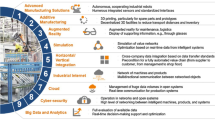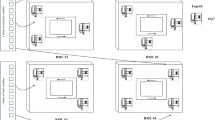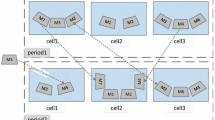Abstract
In a dynamic manufacturing environment, manufacturing cell configurations based on current part mix and production process may need to be revised once the part mix or the production process has changed. However, machine and equipment moving costs make frequent reconfiguration uneconomical and sometimes impossible. Designing a sustainable cellular manufacturing system in a dynamic environment is studied in this paper. An integer programming model is developed to minimize material handling and machine costs as well as cell reconfiguration cost for a planning horizon of multiple time periods. Solving this integer programming problem is NP-complete. A decomposition approach is developed so that the decomposed subproblems can be solved with less computational effort. Dynamic programming is then employed to find a solution of the original problem. Numerical examples are presented to illustrate the model and the solution technique developed in this paper.
Similar content being viewed by others
References
B. Arvindh and S.A. Irani, Cell formation: The need for an integrated solution of the subproblems, International Journal of Production Research 32(1994)1197- 1218.
A. Atmani, R.S. Lashkari and R.J. Caron, A mathematical programming approach to joint cell formation and operation allocation in cellular manufacturing, International Journal of Production Research 33(1995)1 - 15.
A. Bahrami, M. Lynch and C.H. Dagli, Intelligent design retrieval and packaging system: Application of neural networks in design and manufacturing, International Journal of Production Research 33(1995)405- 426.
D.D. Bedworth, M.R. Henderson and P.M. Wolfe, Computer-Integrated Design and Manufacturing, McGraw-Hill, New York, 1991.
J.L. Burbidge, Production Flow Analysis for Planning Group Technology, Oxford Science Publication, 1989.
S.-J. Chen and C.S. Cheng, A neural network-based cell formation algorithm in cellular manufacturing, International Journal of Production Research 33(1995)293-318.
N.-E. Dahel, Design of cellular manufacturing systems in tandem configuration, International Journal of Production Research 33(1995)2079 - 2095.
G. Harhalakis, G. Ioannou, I. Minis and R. Nagi, Manufacturing cell formation under random product demand, International Journal of Production Research 32(1994)47 - 64.
G. Harhalakis, R. Nagi and J.M. Proth, An efficient heuristic in manufacturing cell formation for group technology applications, International Journal of Production Research 28(1990)185 - 198
S.S. Heragu and Y.P. Gupta, A heuristic for designing cellular manufacturing facilities, International Journal of Production Research 32(1994)125 - 140.
S.A. Irani, T.M. Cavalier and P.H. Cohen, Virtual manufacturing cells: Exploiting layout design and intercell flows for the machine sharing problem, International Journal of Production Research 31(1993)791 - 810.
A.M.M. Jamal, Neural network and cellular manufacturing, Industrial Management and Data Systems 93(1993)21- 25.
J.A. Joines, C.T. Culbreth and R.E. King, Manufacturing cell design: An integer programming model employing genetic algorithms, IIE Transactions 28(1996)69 - 85.
J.R. King, and V. Nakornchai, Machine-component group formation in group technology: Review and extension, International Journal of Production Research 20(1982)117 - 133.
A. Kusiak, Intelligent Manufacturing Systems, Prentice-Hall, Englewood Cliffs, NJ, 1990.
H. Lee and A. Garcia-Diaz, Network flow procedures for the analysis of cellular manufacturing systems, IIE Transactions 28(1996)333 - 345.
T.W. Liao, Design of line-type cellular manufacturing systems for minimum operating and material-handling costs, International Journal of Production Research 32(1994)387-397.
T.L. Lin, M. Dessouky, K. Kumar and S.M. Ng, A heuristic-based procedure for the weighted production-cell formation problem, IIE Transactions 28(1996)579 - 589.
R. Logendran, Methodology for converting a functional manufacturing system into a cellular manufacturing system, International Journal of Production Economics 29(1993)27- 41.
H.A. Rao and P. Gu, A multi-constraint neural network for the pragmatic design of cellular manufacturing systems, International Journal of Production Research 33(1995)1049 - 1070.
N.V. Sahinidis and I.E. Grossmann, Reformulation of the multiperiod MILP model for capacity expansion of chemical processes, Operations Research 40,Supp. No.1 (1992) S127 - S144.
L. Schrage, LINDO: An Optimization Modeling System, Boyd and Fraser, Danvers, MA, 1991.
H. Seifoddini, A probabilistic model for machine cell formation, Journal of Manufacturing Systems 9(1990)69 - 75.
N. Singh, Systems Approach to Computer-Integrated Design and Manufacturing, Wiley, New York, 1996.
M.S. Sodhi, R.G. Askin and S. Sen, Multiperiod tool and production assignment in flexible manufacturing systems, International Journal of Production Research 32(1994)1281 - 1294.
D.R. Sule, Manufacturing Facilities: Location, Planning, and Design, PWS Publ. Co., Boston, MA, 1994.
T.L. Urban, A heuristic for the dynamic facility layout problem, IIE Transactions 25(1993)57 - 62.
A.J. Vakharia and B.K. Kuku, Redesigning a cellular manufacturing system to handle long-term demand changes: A methodology and investigation, Decision Sciences 24(1993)909 - 923.
S. Viswanathan, Configuring cellular manufacturing systems: A quadratic integer programming formulation and a simple interchange heuristic, International Journal of Production Research 33 (1995)361 - 376.
U. Wemmerlöv and N.L. Hyer, Procedures for the part-family/machine group identification problem in cellular manufacturing, Journal of Operations Management 6(1986)125 - 147.
U. Wemmerlöv and N.L. Hyer, Cellular manufacturing practices, Manufacturing Engineering 103 (1989)79 - 82.
Rights and permissions
About this article
Cite this article
Chen, M. A mathematical programming model for system reconfiguration in a dynamic cellular manufacturing environment. Annals of Operations Research 77, 109–128 (1998). https://doi.org/10.1023/A:1018917109580
Issue Date:
DOI: https://doi.org/10.1023/A:1018917109580




